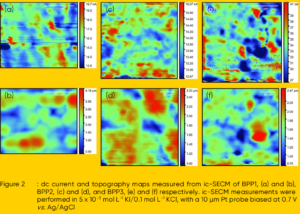Intermittent Contact – Scanning Electrochemical Microscopy studies of the activity and topography of fuel cell Bipolar Plates

Fuel cells are a favored option in the drive to a low carbon economy. An understanding of the components of the fuel cell can aid in better design and manufacture. One such component which should be understood is the Bipolar Plate (BPP). BPP are a key component of fuel cell stacks, and make up 80% of the fuelcell stack weight [1, 2]. The BPP is a multipurpose component acting to separate fuel cells in the stack, distribute fuel and manage water flow through the cell, carry current from the cell, and in some cases, act to dissipate heat from the cell [1, 3, 4]. In this note Scanning ElectroChemical Microscopy (SECM) is used to investigate three different graphitic BPP compositions provided by Eisenhuth GmbH & Co. KG. SECM has previously been used to investigate fuel cell components, though this has mostly focused on the catalytic materials [5-8].
SECM is useful in the study of BPP materials because it can demonstrate the mixing of the conductive particles within the BPP providing information on the production process. In this note Intermittent Contact (ic)-SECM was used on the M470 to obtain further information about the sample topography.
Please click on ‘Request Application Note’ and we will send you the full application note ‘Intermittent Contact – Scanning Electrochemical Microscopy studies of the activity and topography of fuel cell Bipolar Plates’.